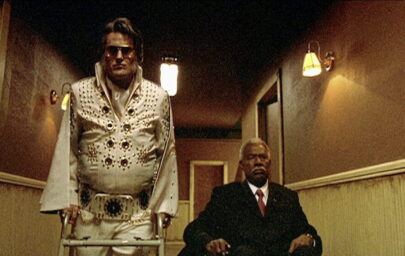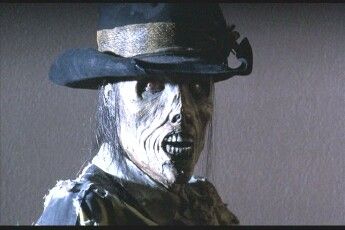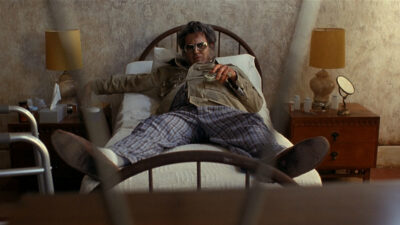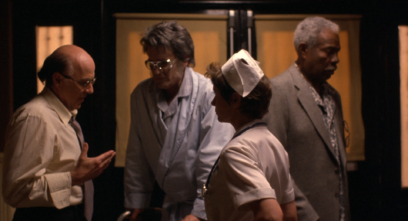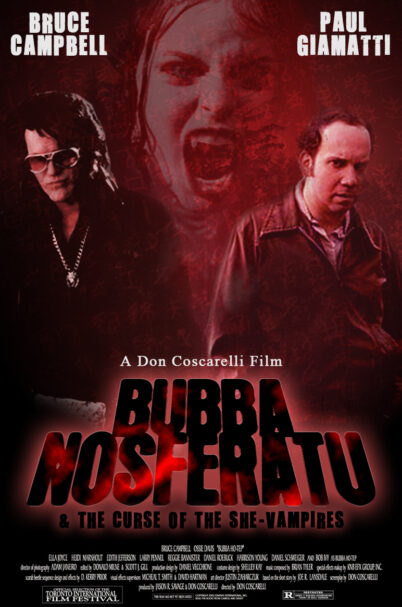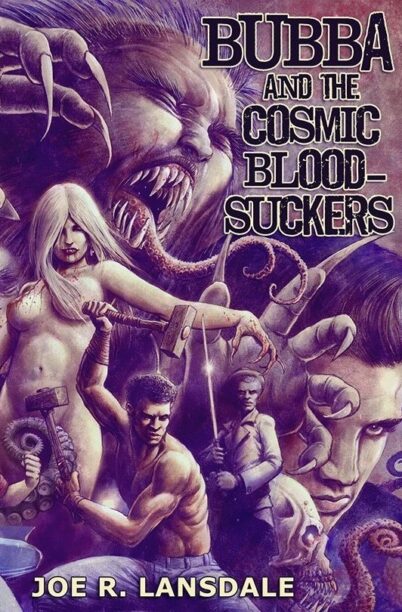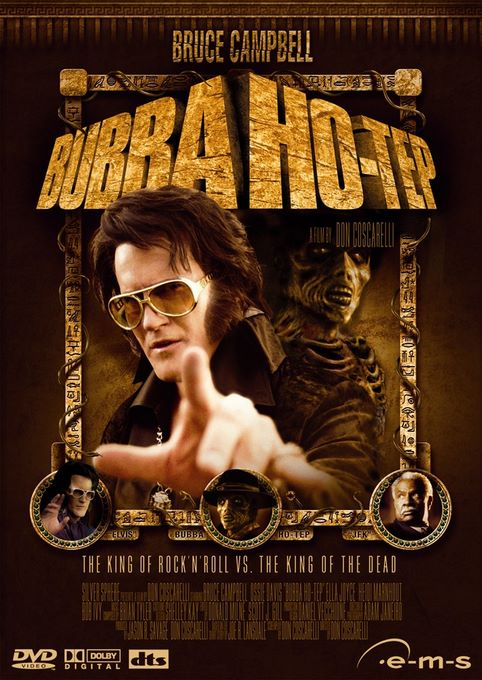 Here’s a film that hasn’t been getting too many retrospectives, but I say it’s deserving of at least one. BUBBA HO-TEP was a low budget horror comedy from writer-director Don Coscarelli (of the PHANTASM films, THE BEASTMASTER, etc.), adapted from a novella by Joe R. Lansdale (of THE DRIVE-IN, THE GOD OF THE RAZOR, etc.) and starring Bruce Campbell (of the EVIL DEAD films) as an aging Elvis Presley battling a mummy whose moniker provided the title. The film was released in the fall of 2003 but completed nearly two years earlier, a behind-the-scenes saga that’s nearly as interesting as BUBBA HO-TEP itself.
Here’s a film that hasn’t been getting too many retrospectives, but I say it’s deserving of at least one. BUBBA HO-TEP was a low budget horror comedy from writer-director Don Coscarelli (of the PHANTASM films, THE BEASTMASTER, etc.), adapted from a novella by Joe R. Lansdale (of THE DRIVE-IN, THE GOD OF THE RAZOR, etc.) and starring Bruce Campbell (of the EVIL DEAD films) as an aging Elvis Presley battling a mummy whose moniker provided the title. The film was released in the fall of 2003 but completed nearly two years earlier, a behind-the-scenes saga that’s nearly as interesting as BUBBA HO-TEP itself.
The aforementioned Joe Lansdale novella debuted in August of 1994, but Bubba Ho-Tep actually made his debut appearance earlier that same year in the Lansdale scripted, Timothy Truman illustrated Topps comic series THE LONE RANGER AND TONTO. It featured a revamped Lone Ranger and his Native American sidekick Tonto, opposed by an unnamed mummy from outer space. THE LONE RANGER AND TONTO’s overtly comedic tone will be familiar to readers of Lansdale’s fiction, particularly the mummy’s actions at the end of the first issue, when he kills a cowboy gambler with the words “And you will hold my death while I hold your life,” followed by: “And while I’m at it, I’ll take your hat and cigar,” thus introducing the cowboy hat wearing, cigar smoking appearance of Mr. Ho-Tep’s later incarnations.
The first of those incarnations was the “Bubba Ho-Tep” novella, which appeared in the anthology THE KING IS DEAD. Lansdale’s outrageous imagination is in full bloom; only he could conjure up descriptions like “The Earth swirled around the sun like a spinning turd in the toilet bowl…and the hole in the ozone spread slightly wider, like a shy lady fingering open her vagina.” His story relates the irredeemably loony account of an aging Elvis who, having switched places with an impersonator years earlier, is stuck in a Mud Creek, TX nursing home with a cancerous growth on his pecker. He teams up with Jack, a black man who believes he’s John F. Kennedy (with dyed skin), to take on Bubba Ho-Tep, a mummy from outer space, and a metaphor for the relentless march of time—so the narrative, despite its outrageousness, has an honest-to-goodness moral about facing old age with strength and dignity.
Coscarelli, upon his first reading the story, claims to have immediately seen its potential as a film. The Hollywood big-shots Coscarelli approached for financing didn’t agree, claiming his screenplay was “ridiculous” and “won’t work with a younger audience,” while Bruce Campbell called it “the weirdest script I’ve ever read.” He nonetheless agreed to headline the film, and the late actor, director and civil rights icon Ossie Davis was persuaded to play Jack.
Filming took place at the Rancho Los Amigos Rehabilitation Hospital in Downey, CA (a convincing enough stand-in for rural Texas). The crew was filled out with frequent Coscarelli collaborators, while the legendary KNB EFX handled special effects that encompassed old age make-up for the fortyish Campbell (courtesy of KNB’s Howard Berger) and elaborate mummy sculpting (by KNB’s Robert Kurtzman).
The result of all that labor is a creepy, side-splittingly hilarious (Jack’s translation of a line of bathroom graffiti is a comedic highlight) and unexpectedly touching piece of work. The tone is understated and subdued, which turns out to have been the correct choice (the story being outrageous enough on its own without the addition of Hollywood bombast), while Lansdale’s uniquely profane Southern-fried aura is captured perfectly, this being a film that, in a most unique and refreshing development, doesn’t sell out its source material.
Campbell and Davis headline a strong cast that includes Ella Joyce as Elvis’ sassy nurse, Larry Pennell as an especially sprightly victim of Bubba H-T, frequent Coscarelli cast member Reggie Bannister as the rest home administrator and ace stuntman Bob Ivy in the title role. Praise must also got to the guitar-heavy score by Brian Tyler, which is satisfying enough to nearly obscure the fact that, due to the prohibitive cost of obtaining the rights to Elvis’ tunes, none of them are heard on the soundtrack.
Drawbacks—yes, there are a few, and they’re pretty hard to ignore—include a plethora of dead spots that would appear to be due to the narration. Taken directly from the Lansdale text, Campbell’s frequent voice-overs aren’t always well timed (as in a late film scene with Elvis pondering the state of his penis, in which the onscreen action appears to have been staged to fit narration that goes by far too quickly). I could also have done without the goofball orderlies played by Daniel Roebuck and Daniel Schweiger, who do nothing but further slow things down (and aren’t helped by the cartoon sound effects that accompany their antics). And the final Elvis-Mummy showdown simply isn’t very exciting or funny, although its lassitude is appropriate given the circumstances; as Roger Ebert wrote, “Assuming that elderly versions of Elvis and JFK ever really did do battle with an Egyptian Soul Sucker, this, I am forced to conclude, is more or less how it would look.”
Coscarelli spent a year on postproduction (BUBBA HO-TEP was one of the first films edited with Apple’s Final Cut Pro software), only to be faced with perhaps the most difficult part of the entire filmmaking process: distribution. It took nearly two years for BUBBA HO-TEP to find its way into theaters, during which time it acquired near-legendary status on the horror circuit (I was among those eagerly awaiting its release) due to extensive coverage on the then-red hot Aint-It-Cool-News site and an enthusiastically received festival run. Despite all that, however, no distributor was willing to take on BUBBA HO-TEP, forcing Coscarelli to four-wall (or self-distribute) his film.
Such issues probably won’t seem too vexing or unique to modern independent filmmakers, for whom theatrical distribution is a largely unobtainable dream. In 2003, though, the fact that this well-made, audience-friendly film was unable to interest distributors showed just how dramatically the independent film revolution of the previous decade had degenerated, with laziness and complacency having replaced the adventurous spirit that guided the movement (which, no surprise, collapsed entirely just a few years later).
Yet Coscarelli’s self-distribution, which involved Campbell making personal appearances at theatres showing the film and fan armies mobilized to distribute flyers and posters, was successful. Furthermore, it was even somewhat influential (I suspect Paramount had the BUBBA HO-TEP rollout in mind when they released PARANORMAL ACTIVITY, which like Coscarelli’s film relied heavily on a carefully curated fan base).
Back in 2003, of course, a theatrical release was merely a preview to what was then viewed as a film’s premiere incarnation: the all-important DVD release. The BUBBA HO-TEP “Collector’s Edition” DVD, distributed by MGM in 2004, was a doozy, containing all the expected extra features (trailers, deleted scenes, making-of featurettes) in addition to a nifty slipcase and, best of all, an audio commentary by Bruce Campbell, in full character as “The King.”
The film’s end credits proclaim that “Elvis returns in…BUBBA NOSFERATU—CURSE OF THE SHE-VAMPIRES.” That proviso was inserted by Coscarelli to blunt BUBBA HO-TEP’s not-entirely happy ending, but the promise of a sequel didn’t go unnoticed by audiences. Pressed into action, Coscarelli (who realized that “if you took the word Bubba and added a monster name after it, you would have a sequel”) quickly scripted BUBBA NOSFERATU, in collaboration with the Texas-based novelist Stephen Romano, and lured Paul Giamatti into signing on to the proposed film as Col. Tom Parker. Yet due to a string of bad luck and waffling on the part of Campbell, whose enthusiasm for the material appeared to have cooled considerably, BUBBA NOSFERATU never reached fruition.
Lansdale wrote his own BUBBA HO-TEP prequel, a novel called BUBBA AND THE COSMIC BLOODSUCKERS (bearing the dedication “This is for Don Coscarelli and Bruce Campbell and to the memory of Ossie Davis who made the film version of BUBBA HO-TEP so much fun”), published in 2017 by Subterranean Press. It isn’t up to the high standards set by the initial novella and film, being a lightweight camp-fest that features a supremely foul-mouthed Elvis battling interdimensional what’s-its together with Col. Tom Parker and a retinue of quirky characters. Missing is the poignancy of its predecessors, and also the novelty, with a convenient mind-wipe device in the final chapter setting the stage for the events of HO-TEP.
A graphic novel adaptation of COSMIC BLOODSUCKERS, scripted by Joshua Jabcuga and illustrated by Tadd Galusha, appeared in 2019, as did another graphic novel, ARMY OF DARKNESS/BUBBA HO-TEP, by Scott Duvall and Vincenzo Federici. The latter purported to unite Elvis with Ash (also incarnated by Bruce Campbell) from the EVIL DEAD films and ARMY OF DARKNESS in another lightweight romp that once again failed to approach the oft-kilter excellence of BUBBA HO-TEP.
As of 2023, the above are all that exist of the BUBBA saga, and I say it’s a good thing this saga hasn’t gone any farther. BUBBA HO-TEP is very much a one-off, a work so unexpected, audacious and plain weird it can never hope to be repeated.

